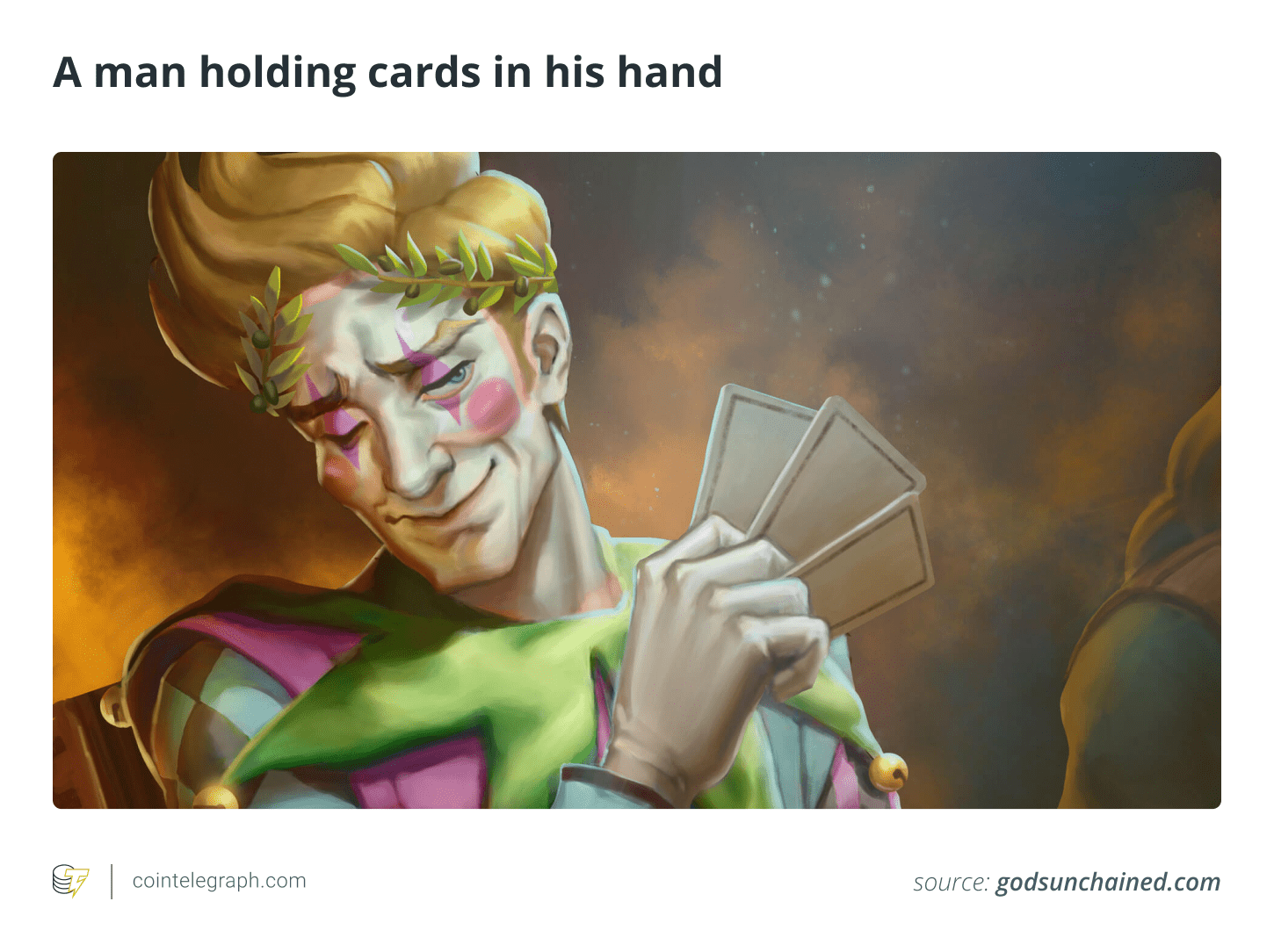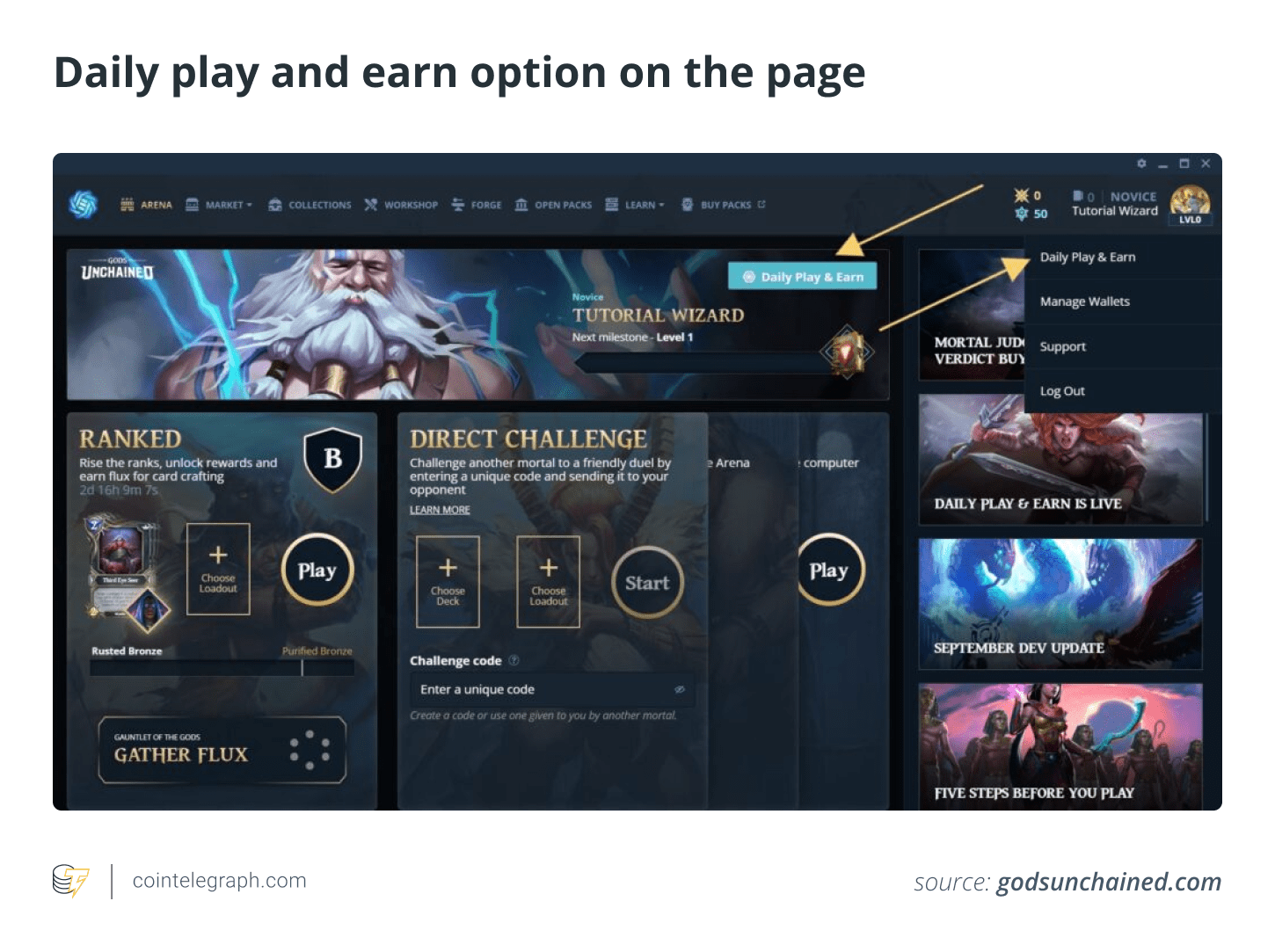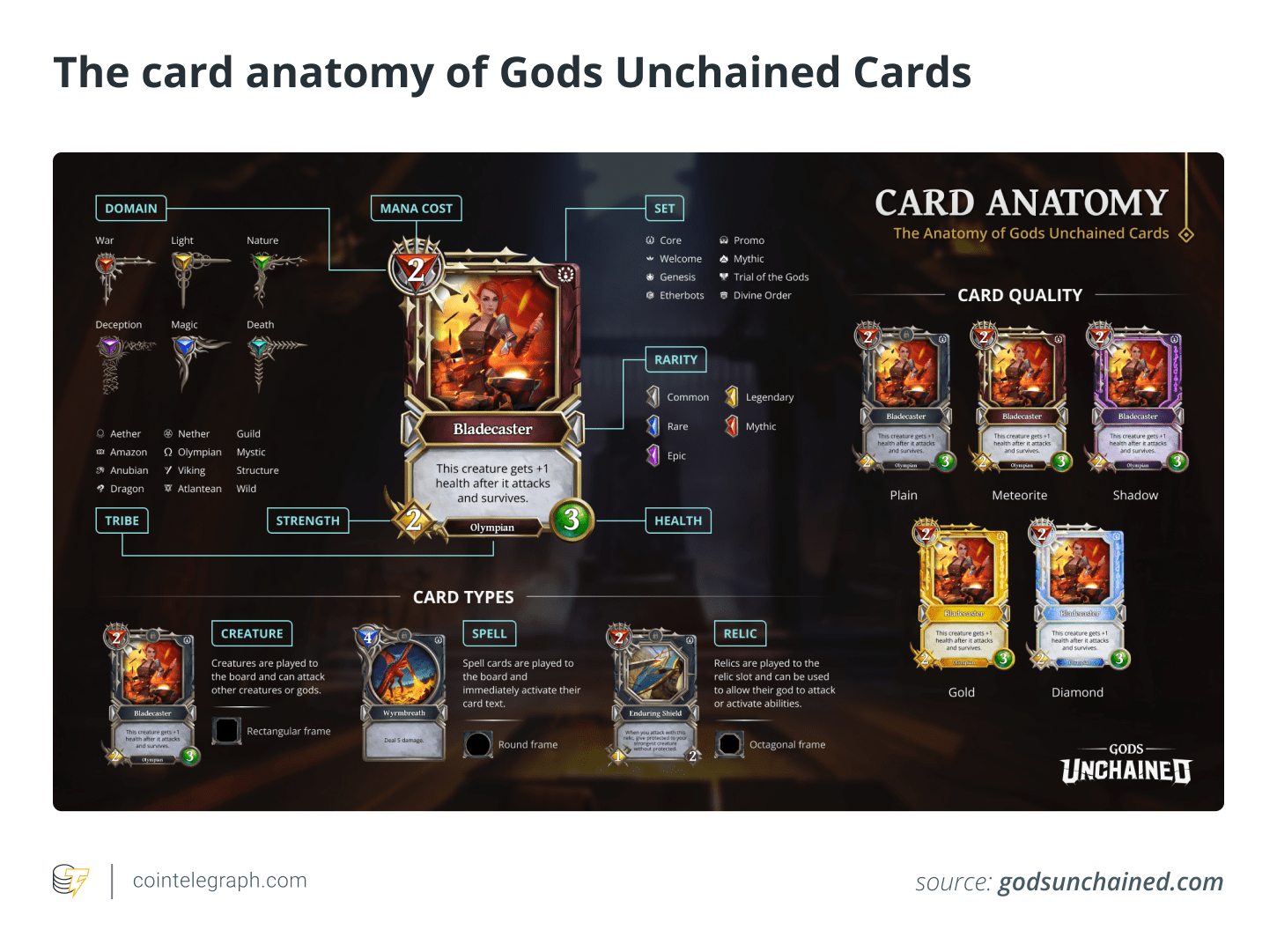What is Gods Unchained, and how to play it

The game-changing possibilities that blockchain spurs through immutability, tokenization and decentralization are immense. The technology has significantly expanded the scope of traditional trading and collectible card games by democratizing the ideals of ownership, scarcity, interoperability, transparency and play-to-earn (P2E).
The excitement factor of trading card games (TCG) — previously confined to school lunch tables and enthusiast get-togethers — has now truly gone global, thanks to blockchain gaming.
Gods Unchained embodies the future of trading card gameplay. It taps into the rich world of marvelous mythical gods and their strengths and weaknesses, represented by over 1,500 unique cards.
What is Gods Unchained?
Gods Unchained is a digital trading card game with fast-paced gameplay and strategic deck building. To succeed in the game, players must align themselves with one of six gods, build decks of 30 cards, and use strategic gameplay to outsmart, subdue or decimate their opponents.
Each game involves tactical decision-making, resource management and card-based combat, with the ultimate goal of reducing the power of the opponent’s guard to zero.

The power behind Gods Unchained
If you are wondering who is behind Gods Unchained, it’s none other than Immutable, an Australian-based game development studio.
The studio is also working on several projects in the gaming and blockchain space, including a nonfungible token (NFT) marketplace, a metaverse gaming offering and a decentralized gaming platform. Gods Unchained offers a diverse collection of cards, a constantly evolving meta, and frequent updates and events, making it an exciting game for players.
The story
Gods Unchained is a blockchain-based trading card game that takes players on a journey through the rich fantasy world of Eucos. Valiant mortals wield powerful magic to overcome epic battles while navigating the conflicting whims of the six domain gods. The gods have been defeated and imprisoned by the titans, who have corrupted the world and enslaved humanity. But a few humans have become god-like, using their powers to fight the titans and liberate humanity.
Players collect and trade digital cards featuring the champions, spells, artifacts, and creatures of Eucos. Through intricate artwork and stats, each card reveals a diverse story from both grand and intimate perspectives. Expansion sets like “Light’s Verdict,” and side stories like “Winter Wanderlands,” constantly add fresh stories, content and characters.
Gods Unchained offers engaging gameplay, and as the stories of Eucos continue to unfold, players can look forward to many more exciting adventures in this vibrant and ever-evolving world.
Gameplay overview: How to play Gods Unchained
Players are matched against each other in a test of skill and strategy. They take turns playing cards, making moves and using their gods’ powers to gain the upper hand. The goal is to reduce the opponent’s health to zero and emerge victorious. The game is fast-paced and action-packed, with plenty of twists and turns to keep players on their toes.
Choosing gods and their powers
Gameplay begins with the players aligning one of the six gods or goddesses of light, death, nature, deception, war and magic. Each god has a unique set of cards, strengths and weaknesses, and choosing the right one can give the players a strategic advantage in the game.
When starting the game, the players must also choose one of three unique god powers that provide special abilities and advantages throughout the game. These god powers can turn the tide of a game, create a powerful advantage or launch a surprise attack on opponents. They are designed to be potent but not game-breaking, so players can still enjoy a fair and balanced gameplay experience.
Creating card decks
Next, the players strategically create their decks of cards. A maximum of 30 cards are allowed, each with unique abilities, stats and artwork. Players can use various combinations of cards to build a powerful deck to defeat opponents.
A deck full of devastating spells can be the key to success. Some prefer a brute-force approach with a deck full of powerful creatures. With so many card options, the possibilities are endless.
Playing the game
The game begins with players entering the mulligan phase, where they can reshuffle cards in their deck that may not be useful in the early stages. It’s wise to shuffle away cards that require more mana (but more on mana later).
Players then use their cards to attack the opponent’s cards or their gods. Each card has an attack and health value, and is removed from play when its health is zero.
Players can also use their god power to gain an advantage over their opponents. Each god power provides a unique ability that can be used once per turn if the player has enough mana to activate it.
As the players rank up, they’re rewarded with resources like flux, favors, starts, the native GODS tokens, card packs and more.
Understanding mana
Mana is a key resource in Gods Unchained. Each card in a deck has a mana cost, and the player must have enough on their mana wheel to play it.
The mana system is a critical gameplay component that requires players to manage their resources to play their cards and gain the upper hand.
Game modes in Gods Unchained
Gods Unchained gameplay offers a variety of game modes for players to enjoy. Each delivers a unique experience, challenging players to build their decks and master the game’s mechanics.
Ranked matches
This is the primary game mode, where players compete against others of a similar rank. Each win earns the player experience points, stars and ranking points, which help them progress up the ranked ladder.
Players can climb up to the following ranks: Rusted Bronze, Purified Bronze, Rusted Iron, Purified Iron, Impact Meteorite, Astral Meteorite, Twilight Shadow, Midnight Shadow, Auric Gold, Solar Gold, Ethereal Diamond and Mythic.
Daily play and earn

This is the primary way players earn in-game currency. Players get new decks to play with each day and earn GODS for completing daily objectives and winning matches.
The Weekend Ranked Event takes place every weekend and rewards players with valuable card packs from the game’s latest expansion sets.
Tutorial missions
New players go through tutorial missions that guide them through the game’s mechanics and reward them with card packs after completion. They are highly recommended for new players to become familiar with the game and build their card collection.
Solo mode
Gods Unchained also features a solo mode where players can practice battling against an AI opponent, testing new decks and strategies without worrying about their ranking or rewards.
Direct challenge
Players can challenge their friends to a game of Gods Unchained by generating a unique code for them to join.
The heart and soul: The cards and deck

Each deck consists of 30 cards that players assemble before the battle. Decks represent their playstyle, and a carefully constructed one is the key to victory. The cards depict specific attack and health values, and the amount of mana required to play.
Gods Unchained cards are categorized based on their domain (i.e., which gods or goddesses the cards align to). Cards not belonging to a particular domain are considered neutral and can be used in any deck.
The game is played with three card categories:
- Creature cards: These attack the opponent’s choice of god or creatures. Players can have up to six creature cards on the board at once.
- Spell cards: These cast spells determined by their text. Once used, they are sent to the void.
- Relic cards: These give players supporting options or allow their god to attack directly. Only one relic card can be active at once, and casting one will replace the previous one.
Creating a winning deck can be challenging for beginners, so the game offers six options for starter decks.
Gods Unchained also features card sets, which are collections of cards grouped by event or theme (free-to-play, promotional, expansion and one-of-a-kind). As with most digital trading card games, regular rollouts of new sets are always expected.
Based on in-game card quality, Gods Unchained cards can also be classified into plain and shiny:
- Plain cards: Non-NFT cards with gray borders; earned by playing the game. They are not tradable on any marketplaces. However, two or more of the same plain card can be transformed into an NFT shiny card by forging (i.e., fusing) them using GODS and flux.
- Shiny cards: The Gods Unchained NFT cards. Variants include meteorite, shadow, gold and diamond.
Specific Gods Unchained cards pertain to card tribes that mark the faction they belong to and feature unique in-game abilities. For example, Anubian cards can draw discarded creature cards back from the void. Gods Unchained tribes include Aether, Amazon, Anubian, Atlantean, Dragon, Guild, Mystic, Nether, Olympian, Structure, Viking and Wild.
Finally, based on rarity, cards in Gods Unchained can be identified as:
- Common (gray gem)
- Rare (blue gem)
- Epic (purple gem)
- Legendary (yellow gem)
- Mythic (red gem)
With so many card permutations and combinations, gameplay possibilities are virtually limitless.
GODS: The blockchain token for the Gods Unchained ecosystem
The Gods Unchained native utility token, GODS, issued by Gods Unchained, is central to the game experience — holding relevance in almost every aspect of the Gods Unchained ecosystem — and enriches its engagement loop.
With a fixed supply of 500 million, players can get GODS rewards in various ways. In daily play and earn, players receive fragments based on their rank and win rate, which are converted to GODS tokens at the end of the event.
The conversion rate depends on the number of active players, rank and daily prize pool. Through the “Offering of the GODS” manual staking, GODS tokenholders can also get additional GODS rewards for actively contributing to the ecosystem through playing, trading, purchasing and forging during every reward period.
Beyond gameplay and staking, the GODS token is also designed to reward players for their contributions to growing the game, and building a thriving ecosystem through community events, surprise rewards, content creation, referrals and more, with 61.5% of GODS supply allocated toward ecosystem development.
The beauty of favor and sanctum
Based on the idea of pleasing the gods, Gods Unchained enables players to build a resource called favor. This can be used to buy powerful cards across the realms from the sanctum, where gods watch the battles.
Favors are essentially rewards for moves that appeal to the gods. Favor resets at the start of each new game. This adds another layer of strategy and minimizes predictability, ultimately making gameplay all the more exciting.
Unlocking NFT possibilities with flux
Akin to favors, Gods Unchained features flux, which are resources that cannot be bought or sold. They can be earned only through wins. The amount of flux earned is determined based on the player’s rank and games played in The Gauntlet of the Gods challenge.
Flux and GODS can be used to forge two or more copies of a core card to create an NFT card that can be sold across NFT marketplaces. Essentially, players can create real-world digital assets. In parallel, it qualifies as a P2E NFT card game.
Stars and the star store: Yet another rewards avenue
Stars are another off-chain resource tied to player accounts. When players win a ranked game, they are awarded a “Star Vial” containing a random number of stars.
Players can receive six Star Vials:
- Nebula Vial: 40 to 60 stars
- Giant Vial: 100 to 200 stars
- Supergiant Vial: 200 to 300 stars
- Supernova Vial: 400 to 600 stars
- Galactic Vial: 1,000 to 1,200 stars
- Universal Vial: 2,000 to 2,500 stars
Once a vial is opened, the player may also be upgraded to the next level. Players can exchange stars for cards via the star store’s rotating list of options, ranging from commons to legendaries. NFT cards are not available in this store. With such rewards, this blockchain-based game is beyond any typical online collectible card game.






 Bitcoin
Bitcoin  Ethereum
Ethereum  Tether
Tether  USDC
USDC  Dogecoin
Dogecoin  TRON
TRON  Cardano
Cardano  Chainlink
Chainlink  Bitcoin Cash
Bitcoin Cash  Stellar
Stellar  LEO Token
LEO Token  Hedera
Hedera  Litecoin
Litecoin  Monero
Monero  Dai
Dai  OKB
OKB  Cronos
Cronos  Ethereum Classic
Ethereum Classic  Gate
Gate  VeChain
VeChain  Cosmos Hub
Cosmos Hub  Algorand
Algorand  KuCoin
KuCoin  Stacks
Stacks  Tether Gold
Tether Gold  Zcash
Zcash  Theta Network
Theta Network  IOTA
IOTA  Tezos
Tezos  TrueUSD
TrueUSD  NEO
NEO  Polygon
Polygon  Ravencoin
Ravencoin  Dash
Dash  Decred
Decred  Synthetix Network
Synthetix Network  Zilliqa
Zilliqa  Qtum
Qtum  0x Protocol
0x Protocol  Basic Attention
Basic Attention  Siacoin
Siacoin  Holo
Holo  DigiByte
DigiByte  Enjin Coin
Enjin Coin  Nano
Nano  Ontology
Ontology  Status
Status  Hive
Hive  Waves
Waves  Lisk
Lisk  Pax Dollar
Pax Dollar  Steem
Steem  Numeraire
Numeraire  NEM
NEM  BUSD
BUSD  Huobi
Huobi  OMG Network
OMG Network  Bitcoin Gold
Bitcoin Gold  Ren
Ren  Energi
Energi  Bitcoin Diamond
Bitcoin Diamond